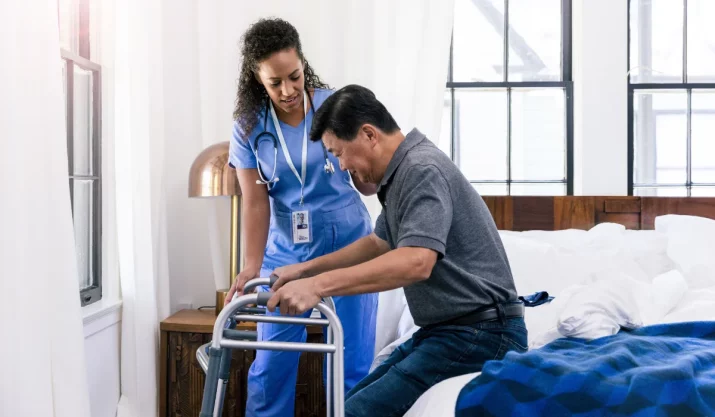New Normal Blood Pressure For Seniors

Table of Contents
Don’t have high blood pressure? That’s great! But are you sure you’re interpreting your readings correctly?
In 2017, the American Heart Association, in conjunction with the American College of Cardiology and a handful of other health organizations, officially lowered the cut-off numbers required to meet the diagnosis for high blood pressure, or hypertension.
For many people, that means that you may now have high blood pressure even if your readings haven’t changed.
What kind of blood pressure measurements should you be looking for—and what can you do to make sure you stay within a healthy range? In this post, we’ll tell you everything you need to know about the new normal blood pressure for seniors.
Key Takeaways
- You may be diagnosed with high blood pressure if your readings are 130/80 mm Hg or higher—down from the previous recommendation of 150/90 mm Hg (note: “mm Hg” is a measure of pressure. It represents how far up a glass column your blood pressure could push liquid mercury). This is regardless of your age!
- Monitor your blood pressure on a regular basis to ensure that it’s within the normal range.
- Lifestyle modifications, like exercising and eating a healthy diet, can go a long way when it comes to lowering your blood pressure.
What Is Blood Pressure?
Blood pressure is simply the force of blood passing through your arteries as your heart pumps blood.
When you measure your blood pressure (or a healthcare professional does it), they’ll place a cuff around your arm that gradually tightens. You’ll be given two readings. The first number, the systolic blood pressure, is the pressure as your heart contracts and pushes out blood.
The second number is the pressure when your heart relaxes and fills back up with blood. This is known as the diastolic blood pressure reading.
When you get your blood pressure measurement, it’ll be in the form of the systolic blood pressure listed over the diastolic blood pressure. Your blood pressure levels are classified based on those two numbers.
Low Blood Pressure vs. High Blood Pressure
Not sure whether you have high or low blood pressure—or a normal reading? Here’s a chart to break things down for you.
Source: American Heart Association, 2024.If your first number is 130 or higher, but the second number is less than 80, this is called isolated systolic hypertension and is caused by age-related stiffening of the major arteries. Technically, it’s a form of high blood pressure that can lead to serious health problems and make the risk of falling more severe. This is yet another reason to check your blood pressure (and take action!) on a regular basis.
Keep in mind that, if you’re an older adult, your first number will often be 130 or higher, but the second number will be less than 80. This is an issue called isolated systolic hypertension and is caused by age-related stiffening of the major arteries.
Technically a form of high blood pressure, it can lead to serious health problems and make the risk of falling more severe. Yet another reason to check your blood pressure (and take action!) on a regular basis.
New Normal Blood Pressure for Seniors
In 2017, the American Heart Association updated its guidelines for high blood pressure standards for seniors.
Before, high blood pressure in most older adults (65+) was classified as being 150/90 mm Hg or higher. For people younger than that, the threshold was 140/90 mm Hg.
Now, the guidelines are lowered to 130/80 mm Hg, regardless of age. As a result of this change, 70 to 79% of men aged 55 and older now meet the diagnostic criteria for having hypertension—men who previously would have been considered healthy.
Blood pressure guidelines are not regularly updated; instead, they’re changed only when sufficient evidence suggests that the old guidelines are no longer relevant. By changing the guidelines, it’ll be easier for patients and their healthcare providers to identify high blood pressure early on—and take steps to address it before complications arise.
And what’s considered the “ideal” blood pressure? While anything under 130/80 mm Hg won’t meet the criteria for a diagnosis of hypertension, all people (regardless of age) should aim for a blood pressure of 120/80 mm Hg.
Low blood pressure guidelines haven’t changed much. These are still demarcated at 90/60 mm Hg or below. The good news is that lower blood pressure tends to be less of a concern for seniors than high blood pressure. However, it’s still worth paying attention to since it can indicate a variety of underlying issues.
These include:
- Allergic reactions
- Severe infections
- Endocrine system problems
- Heart issues
- Vision loss
- Nutritional deficits
Left untreated, low blood pressure can cause symptoms like:
- Fainting
- Dizziness
- Fatigue
- Shallow breathing
Do I Have High Blood Pressure?
Many people are not aware that they have high blood pressure. It often produces no symptoms, which is why it’s referred to as the “silent killer.” However, some individuals with high blood pressure may have symptoms, such as headaches, nosebleeds, visual changes, or chest pain. Anybody can have high blood pressure, but there are certain groups of people who face a higher risk of this disease.
If you’re concerned that you might have high blood pressure, get your readings taken at regular intervals. While you shouldn’t be alarmed by one or two readings that are high or low on the spectrum, it’s important to regularly monitor your readings and to keep your healthcare provider apprised of any changes.
Lifestyle Factors
While some high blood pressure causes might be beyond your control (and we’ll take a deeper dive into these below), there are some lifestyle factors that put you at an increased risk of high blood pressure.These include:
- A poor diet
- Lack of exercise and a sedentary lifestyle
- Overconsumption of salt
- Alcohol consumption
- Smoking
- Sleep deprivation
- Stress
Making a few simple lifestyle changes can go a long way in reducing your high blood pressure, even under the new guidelines.
Seniors
Unfortunately, as you get older, the chances of having high blood pressure also increase. Isolated systolic hypertension is much more common for older people, too.
Men
Men are generally more likely to have high blood pressure—that disparity widens even more when men are younger than 55. After menopause, however, hormonal changes make women just as likely to have high blood pressure as men.
Family History
High blood pressure may run in some families. This may be due to an inherited genetic cause or a shared unhealthy lifestyle, or both.
Race
African Americans also tend to be at an increased risk for high blood pressure.
Primary Hypertension
Primary hypertension (or “essential hypertension”) describes high blood pressure that is not from a distinct cause (which is known as secondary hypertension). Primary hypertension is usually due to a collection of factors, such as unhealthy lifestyle, excessive salt intake, and obesity.
High Blood Pressure for Older Adults
While there are all kinds of risk factors that influence your blood pressure that are well within your control (such as your diet and exercise habits), there are some conditions that are beyond your control, such as genetics, gender, and race.
This is why it’s important to regularly check your blood pressure, even if you’re at a healthy weight and live a healthy lifestyle.
The new AHA blood pressure guidelines “strongly recommend” that any person with high blood pressure monitor their blood pressure at home. You can often find a quality blood pressure monitor for less than $100, and in many cases, your insurance might pay for it.
When shopping for a blood pressure monitor, make sure you choose one that has a display screen large enough for you to read your results, along with an automated monitor. The cuff should inflate itself and it should fit comfortably around your upper arm.
How to Keep Your Blood Pressure In Check
The steps for keeping your blood pressure under control and preventing the complications that go along with hypertension are still the same.
The AHA guidelines suggest treating and preventing high blood pressure via a combination of lifestyle modifications (exercise, diet, salt reduction, and weight loss) and, if necessary, medications.Adjust Your Diet
Take a look at your diet to see what can be improved. Being overweight, even only slightly, adds to your risk of high blood pressure.
Focus on including vegetables, fruits, whole grains, and protein in your diet. Eat a heart-healthy diet to lower your risk of elevated blood pressure. Reduce the amount of sodium (salt) you eat, as your blood pressure becomes more sensitive to salt as you get older.
Get Moving
Exercise is a crucial tool when it comes to keeping a healthy blood pressure. If it’s safe for you, work your way up to at least 2.5 hours of exercise each week. Even brisk walking counts—so get moving!
Stop Smoking and Drinking
Don’t smoke! This increases your risk for high blood pressure along with stroke, heart disease, heart failure, and many other problems. The benefits of quitting can be seen at any age, so don’t think you’re too old for it to make a difference.
Alcohol should be consumed only in moderation. Women should consume no more than one drink per day and men no more than two to see the greatest blood pressure benefits.
Rest and Manage Your Stress
Learn how to manage your stress! Although this is certainly easier said than done, living a lifestyle with well-managed stress is one easy way to reduce your risk of high blood pressure.
Sleep is an integral tool when it comes to fighting high blood pressure, too. Aim for at least 7 to 9 hours of sleep per night, and talk to your doctor if you’ve been told you snore. This can be a sign of sleep apnea, which can increase your likelihood of high blood pressure.
Consider Medication
Medication should be used as a last line of defense in treating high blood pressure, but it can help prevent the serious risks that come with untreated hypertension, such as heart disease and stroke.
There are several different types of medications you can choose from, so you’ll want to talk to your prescriber about which is best for you. The major categories of blood pressure medications include:
- Diuretics
- Beta-blockers
- Angiotensin II receptor blockers (ARBs)
- Angiotensin-converting enzyme inhibitors (ACEIs)
- Calcium-channel blockers (CCBs)
Remember—it’s always best to adjust and engage in a lifestyle that will promote healthy blood pressure before you turn to medication, but certain medications may still be helpful tools in helping you manage this condition.
The Bottom Line
“There’s no such thing as normal”—except as it relates to your blood pressure! By shooting for blood pressure readings that are in the normal ranges, you can prevent a wide variety of diseases. Follow the tips above to get your blood pressure in check and keep it that way—even under the guidelines for the new normal blood pressure for seniors.








